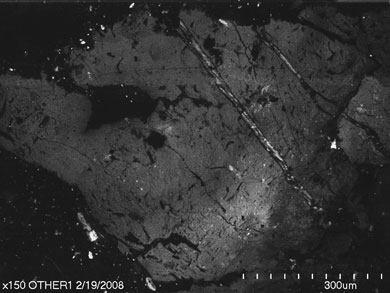
1Geology Dept, Brooklyn College, Brooklyn, NY 11210, 2Doctoral Program in Earth and Environmental Sciences, CUNY Graduate Center, New York, NY 10036, 3American Museum of Natural History, New York, NY 10024
Recent work on the Cretaceous-Paleocene (K-P) transition in the Manasquan Basin of New Jersey (Landman et al. 2007) indicates that the K-P boundary is preserved within the Upper Tinton Formation. The Manasquan K-P boundary is defined by an iridium spike representing the bolide impact linked to the K-P mass extinction event, above which is a 20-30 cm thick fossiliferous, poorly sorted, slightly quartz-rich, glauconitic muddy sand, referred to as the Pinna Layer. Quartz grains in the Pinna Layer are commonly moderate to coarse sand sized. Landman et al. (2007) interpreted this horizon as a survivor community deposited shortly after the impact event. In this study, we report results of our investigation of the origin and provenance of the quartz grains within the Pinna Layer. Pinna Layer quartz grains visible in thin section and in polished hand specimens were examined using polarizing microscopes and an Hitachi S-4700 FE-SEM fitted with a GatanMono CL-3 cathodoluminescence (CL) detector. Although some quartz grains are igneous or metamorphic in origin and thus detrital in character, at least 50% of the quartz grains analyzed have CL signatures typical of authigenic quartz. These grains are typically 0.5-1 mm in diameter, and often occur in clusters. Some have flattened faces. Many appear to have grown in small cavities in the sediment. The detrital quartz grains probably derive from the adjacent Cretaceous land mass, and were undoubtedly transported to the depositional site by the combined action of Cretaceous rivers and coastal currents. These detrital grains show no sign of post-depositional solution and thus could not have been the source of the quartz composing the authigenic grains. Instead, we suggest that dissolution of siliceous diatom tests, deriving from post-impact diatom blooms was the source, and that precipitation of readily mobilized silica from the tests of these phytoplankters produced the authigenic quartz grains.
Michelle O'Dea S. and Matthew P. Garb are students in the CUNY system. John A. Chamberlain, Jr. is Professor and Graduate deputy in the Geology Departmen at Brooklyn College. Becky A. Rudolph and Emily T. Griffiths are laboratory technicians in the Microscopy and Imaging Facilty at AMNH.